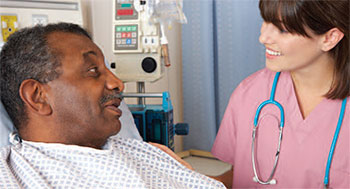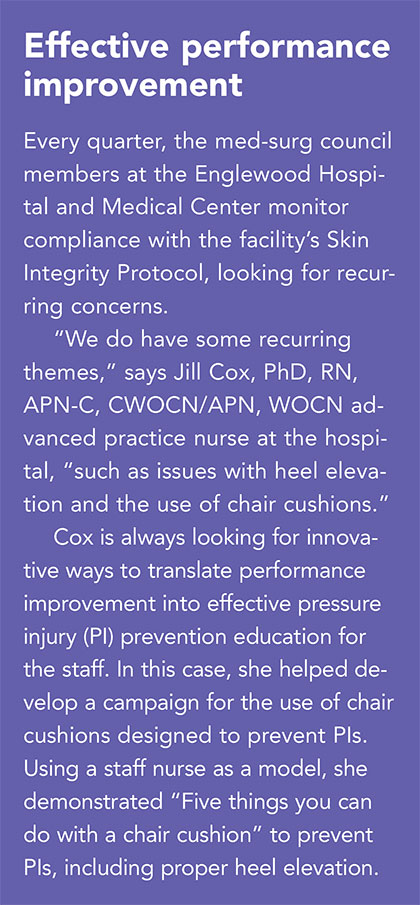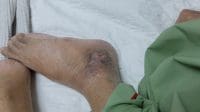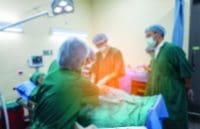How to overcome competing priorities to provide nurse education.
An interview with Jill Cox, PhD, RN, APN-C, CWOCN/APN, clinical associate professor, Rutgers School of Nursing, Newark, NJ. Cox is also a wound, ostomy, continence (WOC) advanced practice nurse at Englewood Hospital and Medical Center. She serves on the board of directors of the National Pressure Ulcer Advisory Panel.
 Medical-surgical (medsurg) units aren’t what they used to be, and neither are the methods needed to educate nurses about preventing pressure injuries (PIs). Keeping the staff of these busy units up to date with the most recent PI prevention practices requires vigilance and ingenuity.“Educating nurses is always a challenge because we have so many competing educational priorities in the med-surg setting, including falls prevention, infection control, and the latest innovations and practices,” Cox says.
Medical-surgical (medsurg) units aren’t what they used to be, and neither are the methods needed to educate nurses about preventing pressure injuries (PIs). Keeping the staff of these busy units up to date with the most recent PI prevention practices requires vigilance and ingenuity.“Educating nurses is always a challenge because we have so many competing educational priorities in the med-surg setting, including falls prevention, infection control, and the latest innovations and practices,” Cox says.
High acuity, high risk
 High patient acuity also competes with educational demands for every moment of a med-surg nurse’s valuable time. Ironically, many factors that keep these nurses so busy are the same ones that increase the risk of PIs. “Med-surg patients have so many comorbidities that increase risk,” Cox says. “The ICU [intensive care unit] patient of the late 1980s is often the med-surg patient of today.”
High patient acuity also competes with educational demands for every moment of a med-surg nurse’s valuable time. Ironically, many factors that keep these nurses so busy are the same ones that increase the risk of PIs. “Med-surg patients have so many comorbidities that increase risk,” Cox says. “The ICU [intensive care unit] patient of the late 1980s is often the med-surg patient of today.”
Patients who require extra diligence to prevent PIs include those transferred from long-term care (LTC) facilities and the ICU. They often have myriad acute and chronic conditions—including nutritional deficiencies, cognitive impairment, limited mobility, numerous comorbidities, and a history of lengthy or multiple surgeries—that put them at high risk for PIs.
“Patients transferred from the ICU are beginning to overcome a critical illness, which can place them at higher risk for pressure injuries,” Cox says. “Recognizing this when they’re transferred to the med-surg unit is important.”
Med-surg nurses also need to be aware of nutritional deficits of patients transferred from the ICU or an LTC. “This puts them at high-risk, and I think it’s underappreciated and understudied in terms of how much of a risk that can be,” Cox says.
Education on the fly
Unique approaches are needed to ensure busy med-surg nurses learn and retain vital information to prevent PIs. Cox believes that the key is to educate creatively, be flexible, and meet med-surg nurses where they are. “Nurses are stretched and don’t have time anymore to attend lengthy on-unit in-services,” Cox says.
She uses a combination of strategies to boost learning and retention, including online self-guided modules and classroom sessions during the orientation process. Staff nurses also are required to complete mandatory education on PIs as part of their annual competency requirements.
Cox has investigated whether a difference exists between a traditional classroom lecture and computer-based instruction in PI knowledge retention. The study revealed that computer modules, which can be completed when nurses have time, are a viable option. Quarterly education to maintain knowledge also was recommended.
In addition, Cox uses teaching tools to educate nurses during their day-to-day practice.
These tools include:
- posters that display easily digestible bites of information, highlighting key educational points
- smaller signs that target a specific topic (signs have included pictures that illustrate the difference between PI and incontinence-associated dermatitis)
- pictures that guide nurses in the proper selection of a bed/mattress when the WOC nurse isn’t available.
“It’s education on the fly. It’s the way nurses flow today,” Cox says.
PI prevention protocol
Englewood Hospital and Medical Center has a comprehensive Skin Integrity Protocol based on the National Pressure Ulcer Advisory Panel guidelines.
As a Magnet®-recognized organization, Englewood participates in the National Database of Nursing Quality Indicators prevalence tracking for PIs. Data collection, which is conducted by staff nurses, includes tracking the admission PI risk and skin condition for all patients in the med-surg and critical-care areas. In addition, nurses conduct a skin assessment, risk assessment, and evaluation of the prevention strategies in use on the day of data collection.
“Consistent risk assessment is crucial,” Cox says. “In our facility, this includes performing a repeat Braden scale [Braden Scale for Predicting Pressure Sore Risk] every shift.”
The Skin Integrity Protocol also addresses:
- standard preventive care
- PI staging
- topical therapies indicated for treatment of each PI stage
- support surface and specialty bed selection.
“When patients are admitted, nurses have the ability to start topical treatment based on the protocol and can order a WOC nurse consult,” Cox says. “Using this protocol provides them with elements of pressure injury treatment so patient care isn’t delayed.”
All PI dressing supplies are stored on the unit for easy nurse access, which saves time and expedites care. In addition, nurses can order specialty beds or mattresses when the WOC nurse isn’t available and a specialty surface is deemed appropriate. These products are generally used for:
- stage 3 or 4 PIs
- unstageable wounds
- any patient the nurse believes may be at high risk for PI.
“I always tell the nurses, if in doubt, go ahead and order the mattress,” Cox says. “We can always remove it if necessary, which we rarely do.”
The benefit of the Skin Integrity Protocol is threefold, according to Cox. “It’s educational, it drives nursing care, and it standardizes care in med-surg and critical care.”
How to stage a pressure injuryAccording to the Scope and Standards of Nursing Practice, staging pressure injuries is an assessment skill that RNs can perform. You can find more information at the National Pressure Ulcer Advisory Panel (NPUAP) web site: Frequently asked questions about pressure injury staging National Pressure Ulcer Advisory Panel position paper on staging pressure ulcers Other resources 2014 Prevention and treatment of pressure ulcers: Clinical practice guideline |
Education = prevention
PI prevention education in the medsurg unit must meet the needs of busy staff nurses. Flexible learning opportunities, collaboration with WOC nurses, and a PI protocol can enhance staff nurse understanding of PIs and increase knowledge retention. The end result is improved PI prevention in high-risk patients.
Editor’s note: This is an excerpt from the supplement “Pressure injuries… Prevention across the acute-care continuum,” which can be accessed online.
*Name is fictitious
Catherine Spader is a medical and healthcare writer and editor in Littleton, Colorado.
Selected reference
Cox J, Roche S, Van Wynen E. The effects of various instructional methods on retention of knowledge about pressure ulcers among critical care and medical-surgical nurses. J Contin Educ Nurs. 2011;42(2):71-8.
Focus 0n Wound Care



















3 Comments.
I READ THIS LECTURE.I learned a lot about pressure injury..thank you for sharing!!
Good information to share with staff. Thank you!
Thanks for sharing this blog regrading woundcare of pressure injuries. It is really useful.